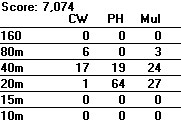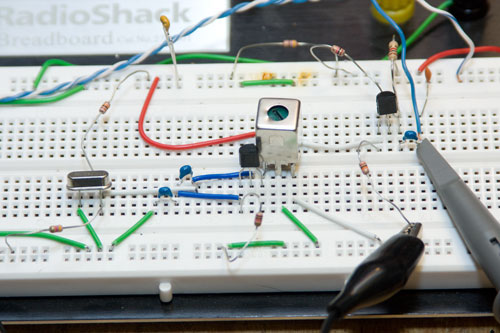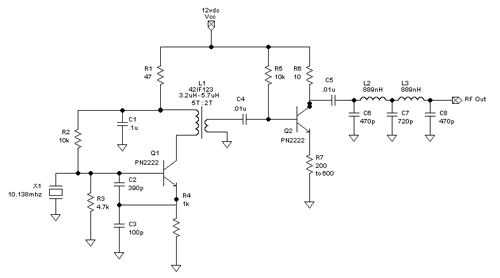30m Oscillator - almost a transmitter (night 3)
I finally got back
to the bench a week after after my last visit to the breadboard.
Don't even ask how I got to the bias values for Q2 as I tried so many
different things tonight that I am not even sure... this what the board had when I
unplugged it and called it a night.

Positive news:
to the bench a week after after my last visit to the breadboard.
Don't even ask how I got to the bias values for Q2 as I tried so many
different things tonight that I am not even sure... this what the board had when I
unplugged it and called it a night.

Positive news:
I
figured out the issue with the filter and the harmonics not being rejected. It turned
out that the ground side of the BNC on the breadboard was not making a good connection.
I moved the wire to a new location to make it easier to connect some test probes and
that resolved it. If I was doing this Manhattan style it would not have been an issue.
:-)
The harmonics are down
18db without the filter and 52db with the filter. The filter is providing 34db of
suppression which is almost exactly what the model suggests that it should do.
If were going to put
this on the air it would be legal. I think that the harmonics need to be down 43db
and I am beating that with the low pass filter + tank circuit.
Less than positive
news:
news:
I am not getting jack
for gain from Q2 at the moment. I can't really measure power very well since I don't
have a RF power meter in this power range. (I am working on that via eBay.)
I went to the oscope and measured the base and collector of Q2 on channels A &
B and it suggests that I am seeing about +25mV of gain peak to peak.
A bonus:
I
was able to make it into a VXO! -----Since it was pretty
stable I decided to grab a variable cap from the one of the junk boxes under the bench.
I connected it from the Q1 emitter (before the Q1e to R4 connection) and the
other side to ground. Sure enough I can swing the frequency. I can move
it from 10,138,400 to 10,170,000. At 10.170 the cap measured about 150pF.
If I was really going to do something like this I would put it on the board (without
long alligator leads) and remove the tank circuit on the collector. The variable cap
impacts the tuning on the tank circuit and also pulls down the power output by
10-15db in the current configuration.
Next steps:
I need to understand
how to calculate gain related to the bias of the transistor. There are so
many ways to approach this and they all have nuances.
I should remove the tank
circuit to make it an all band oscillator. (With the low pass filter and the amount
of feedback the tank is probably not needed.)
I should run the low
pass filter model and come up with values that could be substituted depending on what
band you want to use within the 5 pole design.
I have bunch of trimmer
caps on order... it might be fun to make the cap part of the circuit so that I can
tune this into the QRSS sub band.
I need to determine how
to key this so that it could be used a transmitter at some point down the road.
Eventually I should move
this to a copper board with islands or Manhattan pads to improve the stability as
a test fixture.
2 hours
of bench and documentation time is about as good as it gets at the NG0R QTH.
of bench and documentation time is about as good as it gets at the NG0R QTH.


















